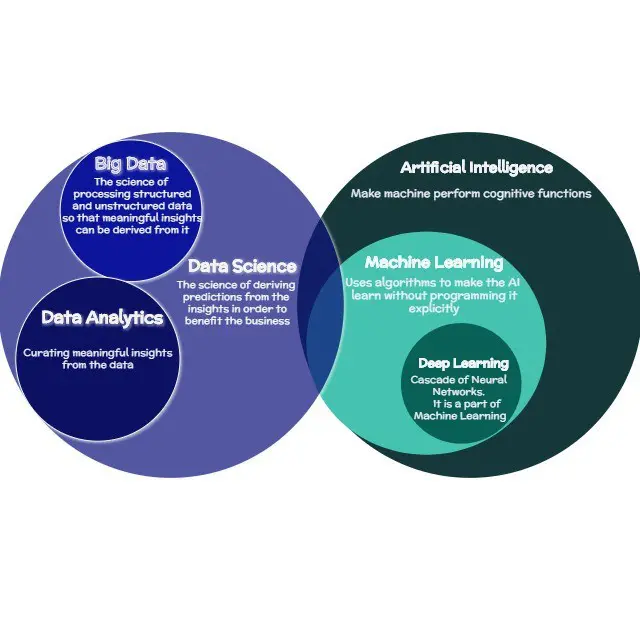Data Science vs. Machine Learning: Here’s the Difference
Data science vs. machine learning (ML) is one of the most talked-about topics in the technology world. The first one represents a broad, interdisciplinary field that tackles large amounts of data and processing power to gain insights. The second one is about feeding a computer algorithm an immense amount of data to start analyzing and making data-driven decisions based on that information.
To uncover the difference between data science and machine learning, let’s look at them separately and compare them with artificial intelligence (AI) and data analytics.
Data Science vs. Machine Learning

Source: TowardsDataScience.com
“Are data science and machine learning the same thing?” is one of the most searched topics. Unfortunately, though these two terms often appear together, they aren’t synonymous.
In today’s rapidly digitizing world, massive amounts of information are created. You must have heard that data is the new oil, mustn’t you? It’s one of the most valuable assets. So, it’s no wonder that this treasured resource lies at the roots of the long-term success of a business.
Each day, the amount of data produced makes up 2.5 quintillion bytes. According to Statista, global data creation will account for over 180 zettabytes by 2025. On average, Google processes over 40,000 searches per second, or 3.5 billion searches each day.
On the other hand, ML enables computers to learn autonomously from the wealth of available information. The value of the global ML market was $8 billion in 2021 and is expected to make up $117 billion by 2027. In 2020, the ML-as-a-service (MLaaS) Market was valued at $1.60 billion and was anticipated to account for $12.10 billion by 2026.
What Is Data Science?
In 1962, American mathematician and statistician John Tukey talked about a field that today resembles modern data science.
This is a field of applied mathematics and statistics. It brings into play a scientific approach to extract meaningful information and insights and predict future patterns and behaviors from data. Also, this field studies how to formulate research questions, gather information, store it, pre-process it for analysis, analyze it, and present the research results in reports and visualizations.
This technology field uses various modeling techniques such as ML algorithms, statistical methods, and mathematical analysis. Namely, it deals with handling the information, cleansing or cleaning it, and understanding its patterns. It can be raw, structured, and unstructured data. Data cleaning is the process of fixing or deleting inaccurate, corrupted, wrongly formatted, duplicate, or incomplete data within datasets.
This field is applicable in more than one industry, including finance, professional services, and information technology. For example, businesses rely on this field to unveil deeper insights that can help them make smarter business decisions, better understand customers, increase security, analyze company finances, and predict future market trends.
It’s estimated that the Global Data Science Platform Market will make up $81.43 billion by 2027.
What Is Machine Learning?
Arthur Samuel used the term “machine learning” in 1959. Samuel was an American IBMer and pioneer in computer gaming and artificial intelligence.
Machine learning represents a subfield of data science. It’s one of the areas of artificial intelligence and one of the branches of computer science. More specifically, ML is at the core of AI.
ML is the study of computer algorithms (e.g., neural networks) that learn by analyzing available databases. Think of an algorithm as a set of instructions applied to solve a problem or accomplish a task.
ML is based on the concept that a computer program can learn, analyze, and adapt to new data without human intervention. The main methods used are called supervised and unsupervised learning methods. They help create a functional model or program by autonomously testing multiple solutions and determining the best fit for the problem.
Deep learning, or deep neural learning, represents a subset of ML. It’s based on neural networks to analyze different factors with a structure like the human neural system.
ML engineers manage the complexities of using algorithms and mathematical concepts.
The application of ML is found in all types of industries, including manufacturing, retail, healthcare, life sciences, travel, hospitality, financial services, media, security, energy, feedstock, and utilities. It can help companies unlock the value of corporate and customer information to make the right business decisions. For instance, image recognition is a well-known example of ML.
Is Machine Learning Better Than Data Science?
When discussing data science vs. machine learning, many say it is good to compare them to determine which one is better.
- Data science allows for predictive causal analytics and prospective analysis. ML will enable companies to observe and study data or experiences to determine patterns and build a reasoning system, considering those findings.
- These two fields are in tight connection with each other. Precisely, ML fits within the broad term of data science.
- Increasingly, it’s getting more critical for data scientists to have a basic understanding of ML.
Both are important. These two fields depend on each other: data is indispensable, and ML technologies have become an integral part of almost all industries.
Is Machine Learning Necessary for Data Science?
This is another interesting question concerning the issue of data science vs. machine learning.
- Data is necessary for machines to learn, and ML is useful for data science. The latter has made ML practical.
- The development of ML has resulted in the advancement of narrow AI applications. By analyzing large chunks of information, ML eases data scientists’ tasks in an automated process and helps with modeling and interpreting big data.
- The better they understand ML, the more quality predictions and estimations they can make and the more thoughtful actions they can take without any human intervention.
Data Science vs. Machine Learning vs. AI
The field of AI research dates back to a workshop at Dartmouth College in 1956. The idea of AI is older than computing itself. AI studies ways to enable machines to think, learn, and solve problems as human brains do. E.g., AI also explores ways to build meaningful conversational interactions with people.
ML has a narrower scope: it’s a part of AI. ML is about techniques that data scientists use to feed machines information. AI makes computers simulate human intelligence.
These three fields are critical to analytics, and other enterprise uses. Namely, the future of performance marketing and customer acquisition counts on AI and ML. With the predictive analytics software, you can input your data and generate scorecards, risk assessment models, or other models based on your specific needs. These needs may include fraud and risk detection, ad tracking, and product recommendations.
Data Science vs. Machine Learning vs. Data Analytics
Data analytics studies how to collect, process, and interpret information. For example, large companies use this field to gather information about their clients and take data-driven steps to build competitive products and services. Moreover, it helps classify audiences based on different demographic groups, analyze their attitudes, and gain a more specific and accurate picture of public opinion.
Data science is broader, while data analytics is more specific. The first one aims to unveil insights and figure out patterns from large datasets to ask the right questions. Moreover, it’s focused on predicting the future by revolving around and estimating the unknown. On the other hand, data analytics aims to find answers and gain insights into existing questions by exploring new perspectives.
Machine learning refers to techniques that data scientists use to allow machines to gain new information without being specifically programmed to do so. Instead, ML engineers create algorithms and programs that help computers with this learning process.
Sum Up
The fields of data science and machine learning are closely related. They’re shaping the future together with data analytics and artificial intelligence. However, they come with different functionalities and pursue other goals.
The former is a field of deep study of information to extract valuable insights from data. The latter is a part of artificial intelligence and a subfield of data science. It enables machines to learn from past information and automatically perform tasks without being explicitly programmed.



